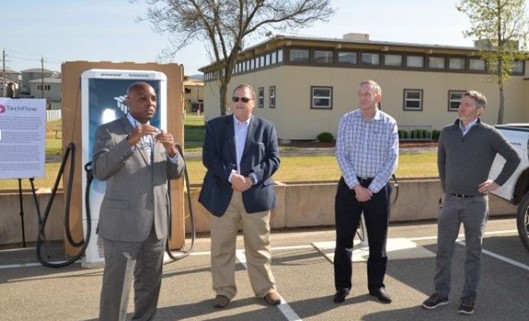
By Natalie Conte, TechFlow Marketing and Communications Intern
With over 400 wildfires ablaze in Canada, the global climate change debate has reignited.
Recently, North American weather patterns funneled smoke from the fires southward, which shrouded much of the eastern U.S. in a dense haze. Consequently, many outdoor activities were canceled, and vulnerable populations were cautioned to stay inside due to poor air quality.
While wildfires are a natural occurrence, their regularity and severity have increased in recent years. In Canada, experts are bracing to battle blazes throughout the summer as firefighters from across the globe team up to contain the over 200 fires the government has classified as “out of control.”
Scientists agree that climate change contributes to the spike in wildfires, with vehicle emissions cited as a significant contributor to greenhouse gas emissions that warm the planet. The U.S. government, a major greenhouse gas emitter, is taking steps to reduce its carbon footprint, with the Department of Defense leading the (electric) charge.
From Emissions to Wildfires: DoD Takes Action to Combat Climate Change
Burning fossil fuels in combustion engines release harmful gases like carbon dioxide, methane, and nitrous oxide into the air. These gases react with sunlight to create ozone, which in turn traps heat in the atmosphere, leading to hotter temperatures and drier vegetation. Under these conditions, it becomes easier for wildfires to start and spread.
The DoD is taking bold action to combat climate change by committing to convert all non-tactical vehicles to electric vehicles (EVs) by 2035. With a long history of overcoming challenges, the military is leading by example and demonstrating accountability, responsibility, and proactive strategic action for the rest of the world to follow.
Championing Renewable Energy with Innovation, Investment, and Intrepidness
The DoD is committed to leading the charge in zero-emission energy and reducing its carbon footprint by adopting EVs for non-tactical use. The DoD’s policy stemmed from an executive order signed by President Biden in 2021, which pledged to make the federal government carbon-neutral by 2050 and adopt an all-electric non-tactical vehicle fleet across the U.S. government by 2035.
Biden’s executive order establishes a comprehensive plan for the U.S. government to combat climate change by reducing its vehicle fleet’s greenhouse gas emissions, which sets benchmarks for success and allocates substantial funding to support the initiative. Additionally, the order mandates the government procurement of carbon-neutral goods and services in the long run, creating a powerful incentive for private companies to align with clean energy standards if they wish to do business with the federal government, which has over $650 billion in annual purchasing power.
Energy Secretary Jennifer Granholm recently expressed unequivocal support for the DoD’s electrification plan during testimony before the Senate Armed Services Committee. While the agency is still in the early stages of transitioning to EVs, the executive branch and Pentagon leadership are optimistic about the prospects.
EVs: A Force Multiplier for the DoD
In the military, a force multiplier refers to any asset or capability that enhances the effectiveness and efficiency of a military force, enabling it to achieve better results with the same or fewer resources. Many people don’t realize that the military’s conversion to EVs isn’t entirely about the environment. Advancing EV technology also provides the DoD tactical advantages on the future battlefield.
“Diversified energy resources and EVs are already beginning to reduce our dependence on unpredictable oil-exporting partners,” Vice Admiral Lee Gunn (Ret.) said in a recent Orlando Sentinel op-ed. “EVs can reduce our exposure to energy supply shocks and, importantly, limit the risk of supply disruptions for military operations.”
While the DoD is focusing on non-tactical vehicles for the initial phase of its EV conversion, Vice Admiral (Ret.) Gunn sees several advantages of EVs in combat operations. “Simply put, the reduced thermal and acoustic signatures of EVs can help secure victory in combat while batteries and renewable energy devices will diminish the dollar and human cost of running fuel convoys,” he said. “The dollar cost of delivering fuel to remote outposts can be as much as $1,000 per gallon, and Army field manuals instruct commanders to anticipate that just one U.S. armored division might require up to half a million gallons of fuel per day.”
How TechFlow is Helping the DoD Reduce Its Carbon Footprint
At the heart of the DoD’s ambitious plan to transition its non-tactical vehicles to EVs by 2035 lies a vital imperative: establishing a rock-solid and reliable charging infrastructure. Just as an awe-inspiring structure crumbles when built upon a treacherous sinkhole, it doesn’t matter how impressive a fleet of EVs the DoD acquires is – if they can’t be charged effectively, efficiently, and sustainably.
To build the EV charging network that will serve as the foundation of the DoD’s electrified future, the DoD recognizes the necessity of collaborating with private sector partners to swiftly enhance its EV charging capabilities. However, navigating the complex processes, policies, and procedures found at bases across the country and understanding the fast-changing energy landscape can be challenging. Success in developing a comprehensive and enduring solution hinges on the DoD’s ability to select collaborative private sector partners with technical expertise and a deep understanding of the DoD’s complexities and unique energy requirements.
With nearly three decades of experience working with the DoD, TechFlow has solidified itself as a trusted partner in driving energy innovations within the military sector. TechFlow’s track record includes developing the first on-base personal vehicle charging solution and the DoD’s first vehicle-to-grid military energy resiliency solution. TechFlow’s contributions continue to help the DoD shape energy innovation and power the military’s rapidly expanding energy needs.
TechFlow is proud to continue its partnership with the DoD and join the battle against climate change to ensure the security of our great nation.





